Deep Tissue Massage for Athletes: Speed Up Your Recovery
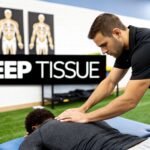
Why Your Athletic Body Needs a Different Massage Approach
An athlete's body is like a high-performance engine, constantly running at its limits and enduring stress that a standard passenger car never would. While a relaxing spa massage might feel like a gentle car wash, it doesn't provide the specialized maintenance an athlete's system needs. The constant strain, explosive movements, and sheer volume of training create unique patterns of tension and micro-trauma that a general massage simply can't resolve. This is why a targeted deep tissue massage for athletes is not a luxury, but a vital part of any serious training plan.
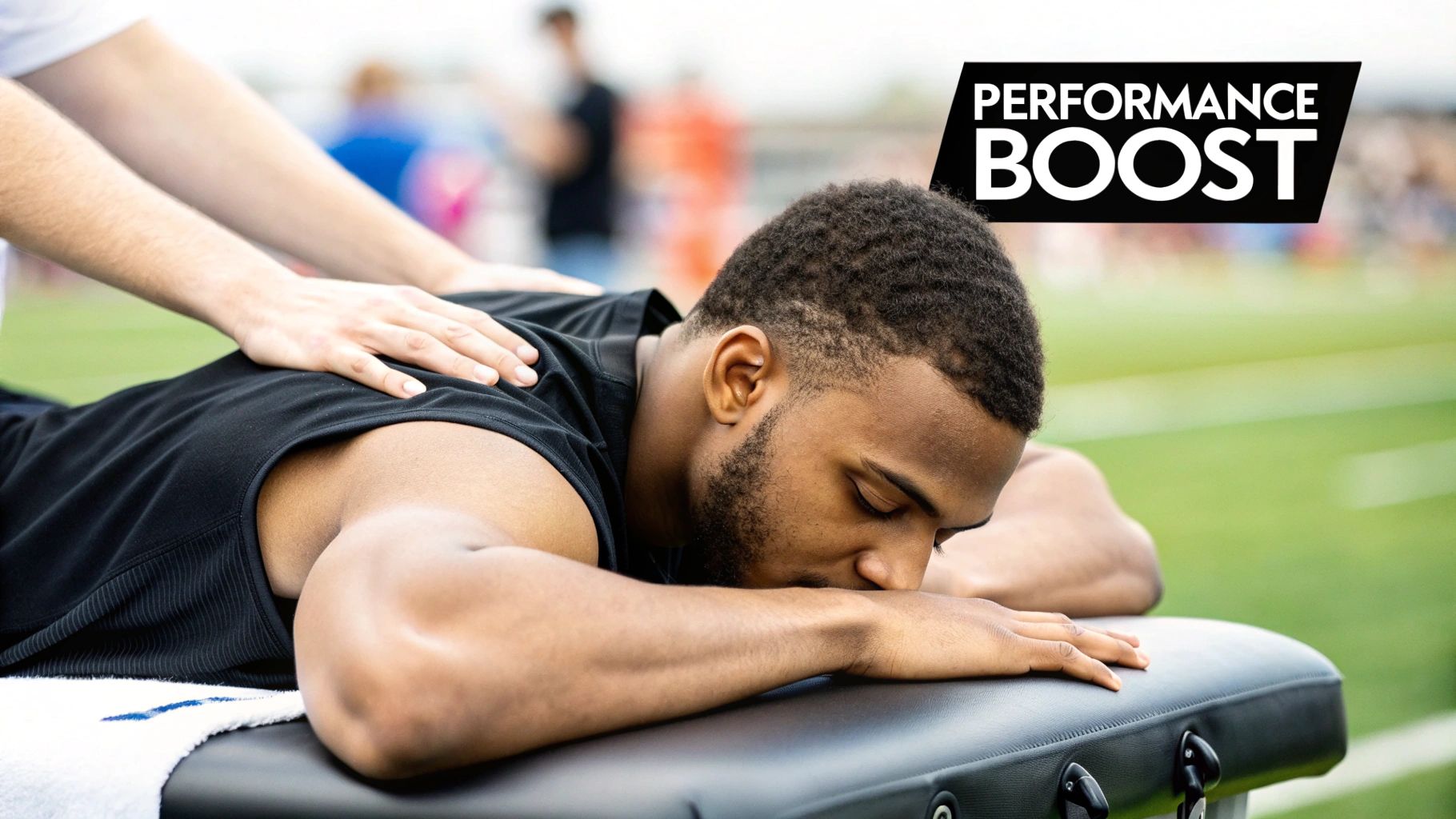
From General Relaxation to Targeted Repair
A standard Swedish massage uses broad, gliding strokes designed for overall relaxation and better circulation in the surface layers of muscle. It’s great for de-stressing, but for an athlete, the real problems often lie much deeper. Years of training build up dense muscle fibers and tough connective tissue, known as fascia. This tissue can develop adhesions and knots—think of them as tiny traffic jams on your body's muscular highways—that restrict movement, block blood flow, and can lead to chronic pain or injury.
A deep tissue massage for athletes gets past the surface to address these deeper issues directly. It uses slow, deliberate strokes and firm pressure to break down these adhesions, restoring proper function and mobility. This isn't about general wellness; it’s about specific, mechanical problem-solving for a body that's been pushed to its peak. For a closer look at how this supports athletic performance, you can check out our guide on sports massage therapy as a recovery game-changer.
The Athlete's Stamp of Approval
There's a reason why the athletic community so strongly supports this type of bodywork. It's not just based on feelings; surveys reveal that over 90% of athletes view methods like deep tissue massage as essential for fixing muscle problems and preventing injuries. This belief is supported by clear benefits, including reduced muscle tension, improved soft tissue function, and a noticeable increase in range of motion.
It serves as both a preventative measure and a powerful recovery tool. To learn more about the science behind these benefits, you can explore the research on massage therapy effectiveness. Ultimately, choosing a deep tissue approach is a strategic decision that acknowledges a high-performance body requires a high-performance maintenance plan.
The Hard Science Behind Athletic Recovery Claims
While athlete testimonials are powerful, it's important to look past anecdotes and see what science says about a deep tissue massage for athletes. The physical effects are real, but they might not be what you assume. Instead of a magic wand that boosts performance, think of massage as a precision tool for managing the fallout from intense training.
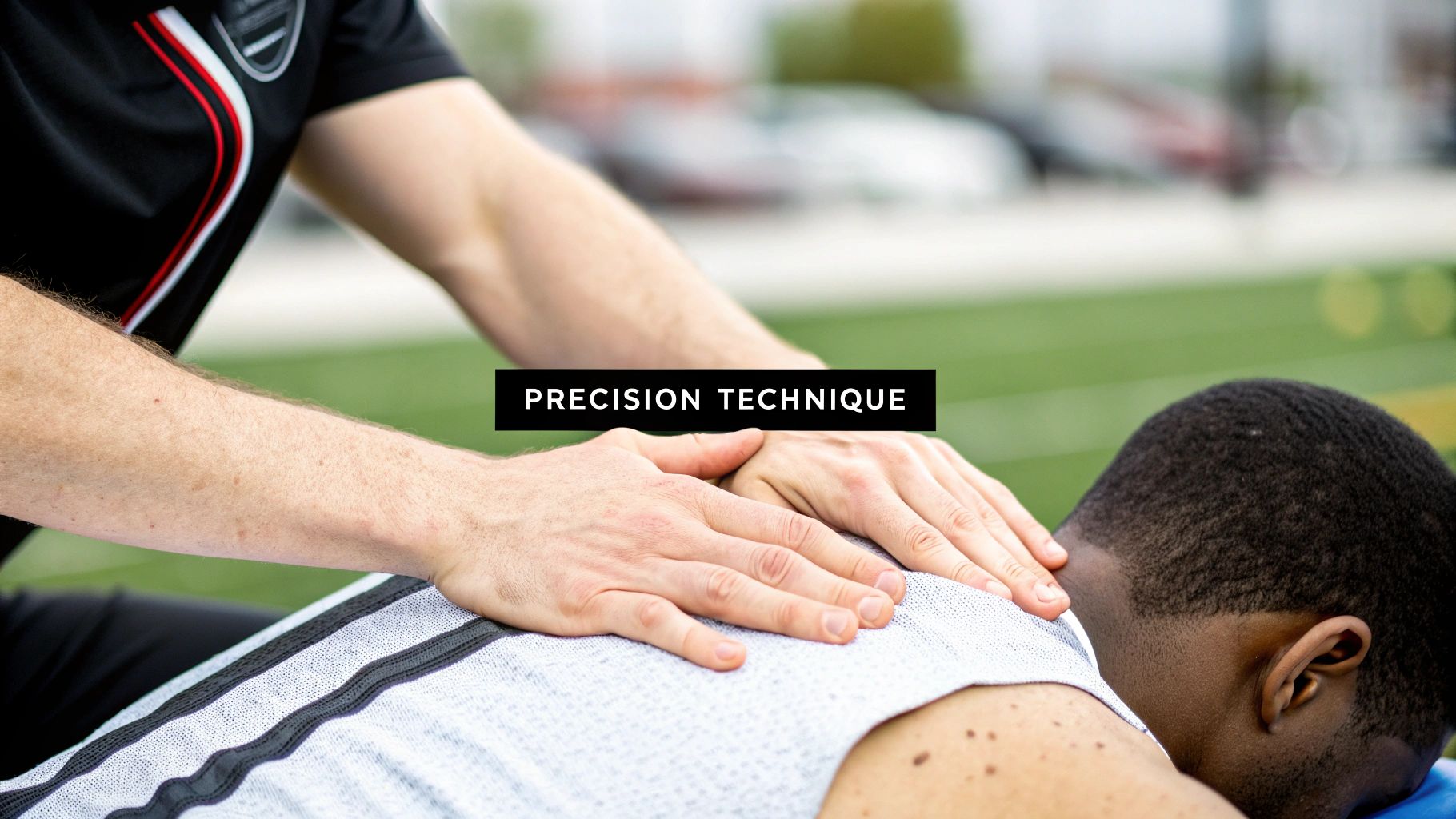
Separating Fact from Hype
The most common claims are tied to better performance and quicker recovery. So, what does the evidence actually show? A large 2020 meta-analysis, which pooled the results from 29 studies involving over 1,000 athletes, offers some clear answers. It found that massage didn't directly improve performance metrics like strength or speed.
However, it did reveal small but significant gains in flexibility and a notable reduction in delayed onset muscle soreness (DOMS) by about 13%. This difference is critical: massage shines in recovery management, not as a direct performance enhancer. You can dive into the full results of this comprehensive sports massage review to learn more.
What’s Happening Inside Your Muscles?
When a therapist applies focused pressure, several key things happen on a cellular level that directly aid your recovery.
- Improved Circulation: The physical pressure on muscle tissue helps get blood moving. This brings fresh, oxygen-rich blood to tired muscles and helps clear out metabolic waste from hard exercise. Imagine it as clearing a logjam in a river, allowing vital supplies to flow freely.
- Fascial Release: Athletes often develop tough, dense connective tissue called fascia. Deep tissue techniques work to break down adhesions in these layers, helping to restore elasticity. This release can improve your range of motion and reduce that feeling of tightness.
- Neurological Response: The intense pressure sends signals to your central nervous system that can help "reset" muscles that are stuck in a state of tension. This is a key part of breaking the cycle of chronic muscle guarding that can lead to imbalances and injury.
Understanding these mechanisms helps set the right expectations. While one massage won't make you faster overnight, consistent deep tissue work can dramatically improve how well your body handles a heavy training schedule. This is one of the main benefits of sports massage that dedicated athletes count on. By prioritizing recovery and tissue health, you build a stronger foundation for consistent, long-term performance.
Mastering the Techniques That Actually Work for Athletes
A common myth is that a deep tissue massage for athletes is just a standard massage with extra force. The reality is quite different. It’s a specialized discipline that requires a deep knowledge of how an athlete's body responds to intense physical strain. A productive session isn't about gritting your teeth through pain; it's about applying specific techniques to resolve issues within the muscle and its surrounding connective tissues.
The infographic below outlines the essential steps for preparing for your session, which helps ensure your body is receptive and you get the most out of the treatment.
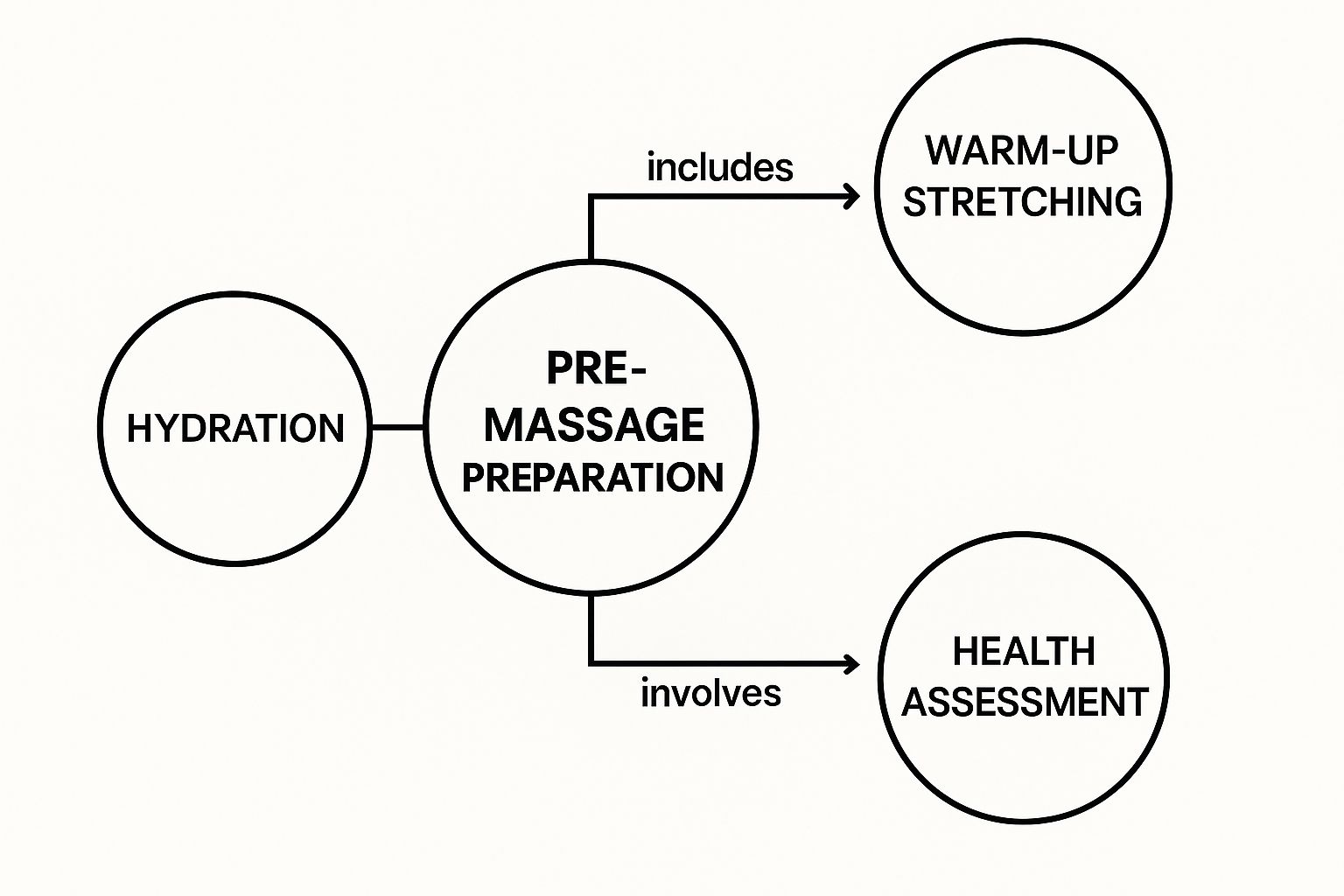
As this guide shows, simple actions like hydrating properly, warming up the muscles, and discussing your health history are the foundation for a successful massage.
Core Techniques for Athletic Recovery
A therapist skilled in sports massage will draw from a toolbox of methods, applying them based on your specific needs. Instead of a one-size-fits-all approach, they will shift between techniques to address different types of tension and restriction as they discover them.
To help you communicate your needs more effectively to your therapist, it's useful to understand the core techniques they might use. The table below details some of the most common methods and their specific benefits for athletes.
Deep Tissue Massage Techniques by Athletic Need
Comparison of massage techniques and their specific applications for different athletic requirements and muscle groups
| Technique | Target Area | Best For | Pressure Level | Session Duration |
|---|---|---|---|---|
| Trigger Point Release | Specific "knots" or hyper-irritable spots in muscles like the upper back, glutes, or calves. | Relieving stubborn, focused pain that may radiate to other areas and restoring normal muscle function. | Intense, sustained pressure directly on the knot. | 15-30 minutes per area |
| Myofascial Stretching | The fascia, or the web-like connective tissue that surrounds all your muscles. Common areas are IT bands and forearms. | Improving overall flexibility, releasing broad areas of tension, and correcting postural imbalances caused by tight fascia. | Slow, gentle, and sustained pressure. | 20-40 minutes per region |
| Cross-Fiber Friction | Tendons and ligaments, especially around joints where scar tissue from old injuries has formed. | Breaking down adhesions and scar tissue from chronic issues like tendinitis, and promoting healthier alignment of healing tissue fibers. | Short, deep, perpendicular strokes across the muscle fibers. | 10-20 minutes per injury site |
These techniques represent the core of an effective deep tissue massage for athletes. A therapist can improve your mobility, speed up recovery, and lower your risk of future injuries by concentrating on these particular muscular and fascial restrictions. This focused work is what makes therapeutic bodywork a world apart from a general relaxation massage.
Building Your Strategic Massage Schedule
Timing is everything when you want to work a deep tissue massage for athletes into a demanding training schedule. Getting a massage only "when you feel sore" is like refueling a race car mid-lap—it's a reaction, not a strategy. A well-planned schedule makes massage a calculated part of your performance and recovery system, designed for your sport, training phase, and body. Remember, more isn't always better; the goal is consistency and smart application.
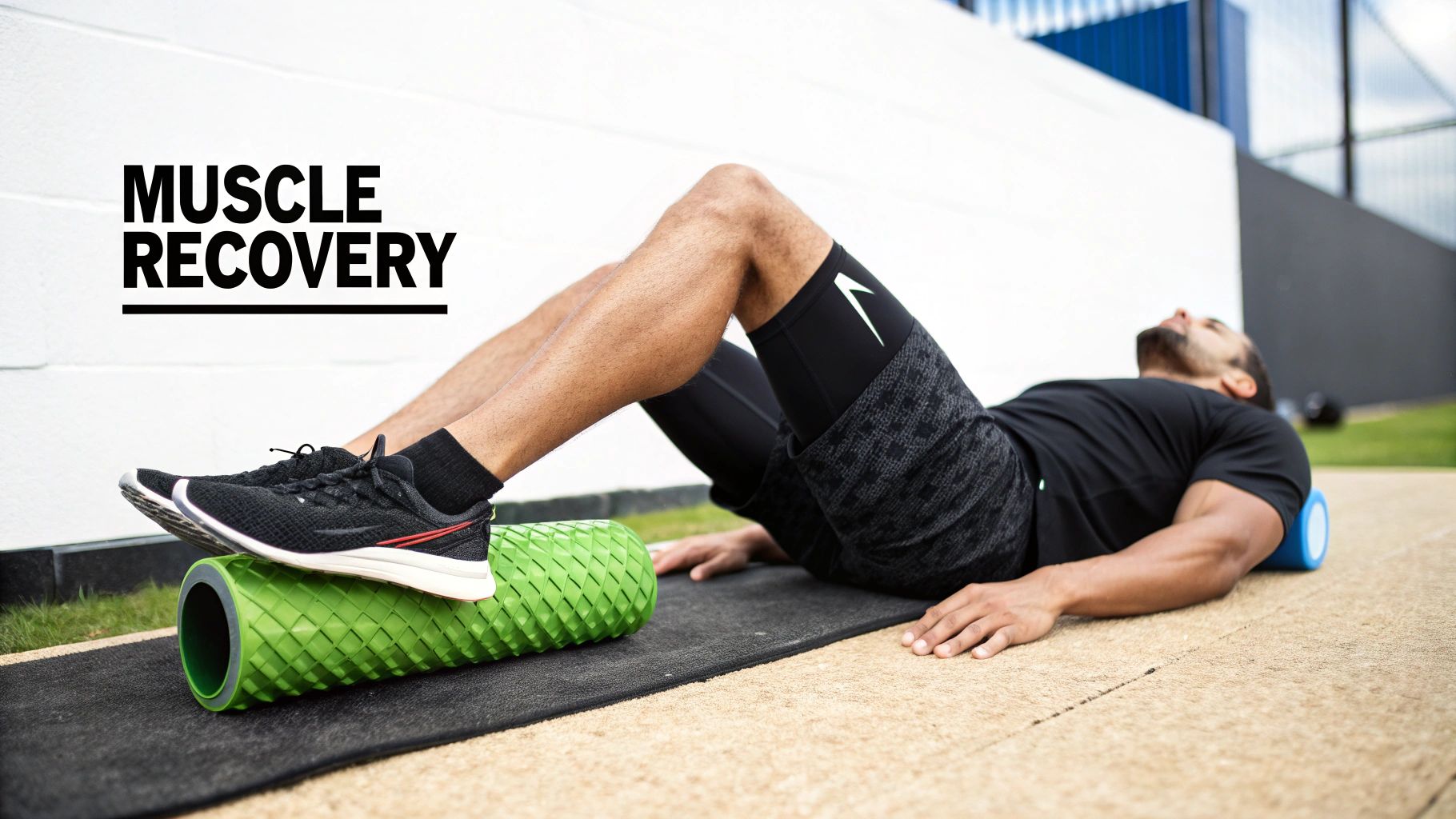
Syncing Massage with Your Training Cycles
Your massage needs will shift depending on where you are in your season. Applying the same frequency year-round is not just inefficient—it can hold you back. Instead, try syncing your sessions with your training blocks:
- Off-Season/Base Building: This is the perfect time for more frequent, intensive work. Sessions every 1-2 weeks can tackle chronic issues, break down old scar tissue, and improve your fundamental mobility before the training load increases.
- In-Season/Maintenance: During your competitive season, the focus changes to recovery and upkeep. The goal is not deep corrective work that might cause soreness. A session every 2-4 weeks is often enough to manage muscle tension and help recovery without disrupting your training.
- Pre-Competition: It's best to avoid a deep, intense massage within 48-72 hours of a big event. This can leave your muscles feeling tired or heavy. A lighter, "flush-out" session is a much better choice to invigorate tissues.
- Post-Competition/Recovery: Scheduling a session 24-48 hours after a major event can significantly boost your recovery. It works by improving circulation and easing the acute tension that builds up during competition.
Finding the Right Frequency for You
So, what’s the magic number for how often you should get a massage? Research consistently shows that a regular, structured approach is most effective. One recent trial discovered that athletes who received bi-weekly 40-minute deep tissue massages over eight weeks reported major improvements in both muscle recovery and performance. This highlights that consistent application is where the real results are found. You can read the full research about these massage frequency findings to see the data for yourself.
Ultimately, your ideal schedule comes down to your sport, budget, and how your body responds. For instance, endurance athletes like runners might need more frequent work on their lower body. Our dedicated guide on sports massage for runners offers more specific advice on this. A good starting point is once a month, which you can adjust based on your training intensity and recovery. Track your performance and soreness levels to discover the perfect cadence that keeps you at the top of your game.
Getting Ready for Maximum Session Benefits
Maximizing the value of a deep tissue massage for athletes begins long before you arrive for your appointment. Just as you prepare for a demanding workout, a little prep for your massage can ensure your muscles are ready for treatment and the therapist can work more effectively. This isn't just about showing up; it's about taking strategic steps to amplify your results.
Think of smart preparation as priming a canvas before an artist starts painting—it creates the perfect surface for detailed, effective work. Without it, your therapist might spend precious time just working through superficial tension.
Your Pre-Session Checklist
To truly get the most out of your massage, focus on a few key areas in the hours leading up to it. These straightforward actions can make a huge difference in your comfort and the session's overall impact.
- Hydrate Strategically: Well-hydrated muscle tissue is more flexible and less likely to cramp under pressure. Drink plenty of water the day before and on the day of your massage. However, it's wise to taper off about an hour beforehand to avoid needing a break mid-session.
- Time Your Meal: Avoid eating a large meal within 90 minutes of your massage. While a light, easy-to-digest snack is perfectly fine, a full stomach can lead to discomfort, especially when you are lying face down on the table.
- Warm Up Your Tissues: A warm shower or a few minutes of light stretching before you head to your appointment can help your muscles begin to relax. This initial loosening allows your therapist to access deeper tissue layers more quickly and with less discomfort for you.
Communication Is Key
The most critical part of your preparation is communication. Your therapist isn't a mind reader, so arriving a few minutes early to discuss your session goals is essential. Be specific about your recent training, point out any areas of pain or tightness, and be clear about what you want to achieve.
Tell them about your latest long run, a tough day of lifting, or that nagging ache in your shoulder. This context helps them tailor the deep tissue massage for athletes to your exact needs, turning a generic session into a targeted treatment. Remember, effective therapy is a partnership built on clear dialogue and shared goals. The more information you share, the better your therapist can address the root causes of your discomfort and help you reach your recovery objectives.
Maximizing Recovery After Your Session
The benefits of a productive deep tissue massage for athletes don't stop when you get off the table. What you do in the following 24 to 48 hours is just as crucial as the session itself. Think of it like this: your massage therapist has done the heavy lifting, breaking down adhesions and releasing tight muscles. Now, it's your job to clear out the "metabolic debris" and allow those tissues to heal properly.
Your actions during this critical window can either solidify the gains you've made or accidentally undermine them. Proper aftercare is key to managing the expected soreness and ensuring your muscles recover fully, ready for the next challenge. This tenderness is a normal response, much like the delayed onset muscle soreness (DOMS) you feel after a demanding workout. It's a sign that deep, restorative work has occurred.
Your Post-Massage Recovery Timeline
To get the most value from your massage, a structured approach to recovery works best. This helps your body flush out metabolic byproducts released from the muscle tissue and supports the healing process. The goal is to move from a state of repair to a state of enhanced performance.
Below is a simple timeline that breaks down what to do and what to expect in the hours and days after your session. It’s designed to guide you through the recovery process safely and effectively.
Post-Massage Recovery Timeline and Actions
This hour-by-hour guide shows optimal recovery actions and what to expect after deep tissue massage sessions.
| Time Frame | Recommended Actions | What to Expect | Warning Signs |
|---|---|---|---|
| 0-4 Hours Post-Massage | Hydrate immediately with water or an electrolyte drink. Perform very gentle, dynamic stretches like slow arm circles or leg swings. | A feeling of deep relaxation, maybe some lightheadedness or grogginess. | Sharp or shooting pains, persistent dizziness, or extreme fatigue that feels unusual. |
| 4-24 Hours Post-Massage | Continue hydrating. A warm Epsom salt bath can work wonders for muscle soreness. Avoid strenuous exercise, alcohol, and caffeine. Light activity like walking is ideal. | Mild to moderate muscle soreness, similar to the ache after a good workout. The areas your therapist focused on may feel tender. | Severe pain that restricts your normal movement, significant swelling or bruising, or any flu-like symptoms. |
| 24-48 Hours Post-Massage | Reintroduce light to moderate exercise. Continue with gentle stretching and foam rolling. Listen to your body and avoid pushing through any sharp pain. | Soreness should be noticeably better. You might feel an increased range of motion and less muscle tension. | Any pain that gets worse instead of better, or soreness that continues for more than 72 hours. |
Following these steps helps ensure your investment in a deep tissue massage for athletes truly pays off. By focusing on smart hydration, gentle movement, and intelligent training adjustments, you can turn a single session into a powerful boost for your long-term recovery and performance.
If you ever feel that your soreness is excessive or lasts longer than three days, be sure to let your therapist know. This feedback allows them to adjust the pressure and techniques in future sessions to better suit your body's needs.
Your Complete Deep Tissue Massage Action Plan
Now it’s time to put all the pieces together. Let’s build a smart, personalized strategy that fits your athletic goals, your training schedule, and your real life. Think of deep tissue massage for athletes not as a one-time fix but as a consistent part of your routine. This action plan will walk you through creating that system, from finding the right therapist to tracking your results.
Finding a Qualified Sports-Focused Therapist
This is the most critical step. You need a therapist who truly understands the specific stresses that athletic training puts on a body. Not all massage therapists are prepared to deliver the targeted work required for peak performance and recovery.
- Look for Credentials: Search for therapists with certifications in sports massage or neuromuscular therapy. These specializations mean they've undergone advanced training in anatomy, how the body moves (kinesiology), and managing injuries.
- Ask About Their Experience: A key question is, "Have you worked with athletes in my sport?" A therapist who helps runners will have different insights and techniques than one who primarily works with powerlifters. Their specific experience matters.
- Conduct an Interview: Don't be shy about scheduling a short consultation call. Ask about their philosophy on deep tissue work, how they manage pressure, and how they ensure open communication during a session. A great therapist will treat the session as a partnership.
Establishing Clear Goals and Communication
Once you have a therapist, the next step is to build a strong working relationship. A massage session shouldn't be a passive event where you just lie there; it's a team effort.
Before each appointment, have a quick chat about your recent training. Mention any specific areas of soreness, tightness, or pain. Be clear about your goals for that day's session. Most importantly, be honest about pressure. Effective deep tissue work is intense, but it should never be agonizing. A pressure level of 7 or 8 on a 10-point scale is often the ideal zone for getting results without causing damage.
Measuring Success and Adjusting Your Plan
How do you actually know if your massage plan is paying off? You need to track your progress. While feeling less sore is a great sign, adding some objective measurements will give you a clearer picture.
Start monitoring key indicators like your range of motion in tight areas (how far can you stretch?), how quickly you bounce back from tough workouts, and even your sleep quality. If you see steady improvements in these areas, you're on the right track. If you hit a plateau, it might be time to tweak the frequency of your massages or talk to your therapist about trying a different approach. Remember, a deep tissue massage for athletes is a dynamic tool. Your plan needs to be flexible enough to change with your training cycles, whether you're in the off-season or peak competition season.
Ready to integrate professional massage therapy into your training? At La Moon Massage and Facial, our experienced therapists specialize in treatments that aid recovery and soothe tired muscles. Book your session with us today and start building your personalized recovery plan.
